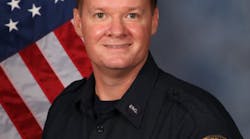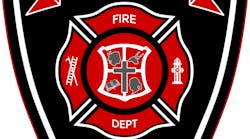The City of Pittsburgh Emergency Operations Center (EOC) dispatched a first-alarm assignment for a possible structure fire. Engine 4, which was going to participate in the parade, was one of the first-due units on the initial alarm. One of the first companies to arrive on the scene, the crew from Engine 4 entered the church to investigate. Interior crews reported a moderate smoke condition inside the church. The Engine 4 crew advanced a line to the basement, where the electrical room is located. Once in the basement, crews encountered heavy smoke and high heat, and they began searching for the seat of the fire.
The district battalion chief requested a second alarm for additional manpower. Deputy Chief David Manfredo, who was already on his way to the scene when the second alarm was dispatched, arrived and assumed command. Manfredo gave the EOC an initial size-up: A very large stone church, approximately 75 by 75 feet, with a three-story attached addition as an exposure on the sector D side of the church. Command reported that crews were still searching for the seat of the fire.
At Fire Station 4, numerous firefighters were donning their dress uniforms and preparing to march in the parade, which was to begin at 10 A.M. The firefighters listened to the progress of the fire on their radios, hoping that their comrades would locate the seat of the fire, quickly extinguish it and be back at the station in time to join them in the parade.
Interior crews in the church basement advised command that the fire appeared to be above them, between the basement ceiling and the floor of the sanctuary. They also reported that the smoke and heat conditions in the basement were intensifying, and requested that the crew from Truck 4 open up the floor in the sanctuary. At 9:15, command requested a third alarm for additional manpower, as crews were still having difficulty accessing the fire. Crews in the basement advised command that conditions were deteriorating rapidly and that they observed thick smoke being sucked in and out of the basement ceiling. Immediately, Manfredo ordered all crews out of the building.
Command advised the EOC to transmit the evacuation tones over the radio, as air horns sounded on the apparatus at the scene. As the additional alarms were being transmitted, the firefighters at Fire Station 4 filtered outside in front of the bay doors and gazed up on the hill, where they could see the billowing smoke.
Moments after the evacuation order was given, but before all of the firefighters could evacuate, a backdraft occurred, blowing out the stained-glass windows and the front door of the church. The force of the backdraft blew one firefighter off of a ladder and he received a wrist injury. Five other firefighters suffered minor burns. EMS evaluated the injured firefighters and transported them to a hospital, where they were treated and later released.
Moments after the backdraft, command requested a fourth alarm for additional manpower and water supply. At least two aerials were set up for master stream operations, and several mounted and portable deck guns were put into operation, as were several handlines. Heavy smoke billowed from all sides of the large stone church.
Despite the raging fire, the parade went on as scheduled. As bag pipers marched, playing their pipes, smoke plumed in the distance. As firefighters marched along the parade route into downtown Pittsburgh, their comrades continued to battle the intense blaze. Flames leaped from the steep church roof and thick, black smoke could be seen for miles as the roof burned off of the church. For the next two hours, firefighters poured water through the windows and into the large opening created when the roof burned off, as other firefighters protected the attached exposure.
For the most part, the flames were darkened and the smoke had turned to steam by noon. Shortly after noon, Battalion Chief Charles Brace led several firefighters into the vestibule of the church. Their assignment was to set up free-flowing hoselines in strategic places within the structure to douse pockets of fire that were still burning under the debris from the roof and sanctuary, which had collapsed into the basement.
Without warning, at 12:19, the church bell tower collapsed, sending large timbers, bricks and other debris crashing through the vestibule and sanctuary and into the basement. Stones and bricks showered onto the street below, striking several firefighters and pinning them to the ground. Manfredo was one of the firefighters struck by the falling debris, and was seriously injured. Assistant Chief Arthur George immediately assumed command and requested a fifth alarm for manpower, due to the numerous injured firefighters.
It was discovered that two members, Brace and Master Firefighter Richard Stefanakis were missing and believed to be trapped under the rubble in the church. Firefighters, some using just their hands, others using axes, pike poles, pry bars and other tools, dug through the debris in an effort of rescuing their comrades. Several City of Pittsburgh EMS units rushed to the scene. EMS supervisor requested several additional ambulances and rescue trucks from outside agencies. In all, 28 firefighters were injured in the collapse. They were evaluated by EMS and transported to local hospitals.
The Urban Search and Rescue (USAR) Strike Force based in Latrobe, in Westmoreland County, was called to the scene to assist in rescue efforts. The team is comprised of numerous advanced-level rescuers from various counties as well as 24 City of Pittsburgh EMS, paramedics and firefighters, who were already on the scene.
Shortly after 2 P.M., rescuers located the bodies of Brace, 55, and Stefanakis, 51, buried beneath the rubble. It took rescuers two more hours of digging to reach them. Firefighters remained on the scene until late in the night. A large crane was brought in to knock down several walls, as there was a danger that they too would collapse.
In the days following the fire, investigators from the City of Pittsburgh Arson Squad, Allegheny County Fire Marshal?s Office and federal Bureau of Alcohol, Tobacco, Firearms and Explosives (ATF) began work to determine the cause of the fire. Ebenezer Baptist Church, a historical landmark, was built in 1873. A fire tore through the church in 1976, causing $300,000 in damages. The church was rebuilt after that fire.
Brace joined the Pittsburgh Bureau of Fire in 1973. He moved up through the ranks and was promoted to battalion chief in 1997. Stefanakis joined the bureau in 1974.
David P. Novak is president of 9-1-1 Response Photography and vice president of The North Boroughs Fire News. He has been involved in the volunteer fire service for 20 years.











